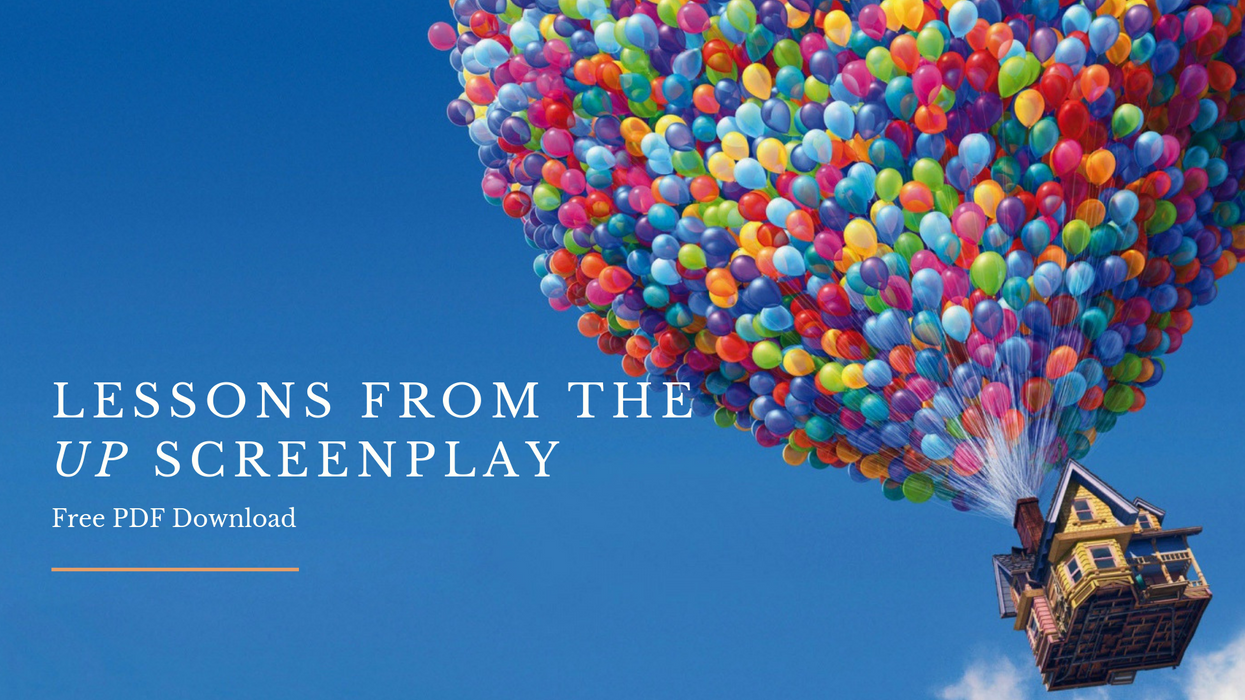Read and Download the 'Up' Script [Free PDF Download]
The "Up" script crushed our hearts in the opening five pages, only to spend the next ninety-five putting it back together. Let's look at some lessons for the script.

I saw the movie Up in a theater in Ocean City, New Jersey on a family vacation. It was raining and there was nothing to do. So we traipsed into the theater not knowing what to expect. My entire family got emotionally rocked and now, every time I see a balloon, I get all choked up thinking about the meaning of everlasting love.
That might just be me, but I bet you've found similar circumstances surrounding the movie unless your heart is made of stone.
So, today we're going to go over the Up screenplay, look at a few lessons, and talk about why it's so effective.
And don't forget to download the Up screenplay PDF in the link below the trailer.
Download the Up screenplay PDF here!
The Up opening montage
When you think of the movie Up, I bet you think about the excellent opening montage. That bold choice really sets the tone of the story and gives us a ton of backstory on our protagonist.
We'll get into characterization later, but first I want to look at how the montage is formatted on the page.
The scenes are written generally with headings and formatted correctly, but they flow into one another with perfection. When it comes time to break the savings jar, we see that written as a series of shots and broken down into a list.
But the true beauty is how simply each scene is written. There's nothing too flowery here. Just solid storytelling. Plus a bunch of scenes that mirror one another as the couple gets older. These mirrored scenes are so effective because they can show physical change and emotional change in tight real estate.
But how does it look on paper? Check out the first few scenes from the Up screenplay.
The Characters in Up
Up is a fantastic film when it comes to character development and character arcs. At the center, we follow Carl and Russell as they journey across South America to lay Ellie's house to rest. Carl is a curmudgeon who never got adventure in his life. Russell is a precocious boy who needs to earn merit badges but doesn't have a father figure to guide him.
What makes this duo special is that they play off the tropes and archetypes we've seen before and really amp up the emotion and comedy. The juxtaposition of young versus old, and adventurous versus cantankerous helps each character find what they need and also meet in the middle.
The ending of Up
Another great and standout thing to learn from the Up screenplay is how the story ends. A young Carl dreams of being an explorer. He has his idol, Charles Muntz, who seems to accomplish everything Carl sets his sights on. But Carl finds love. And Ellie opens him to a world of adventure at home.
Later, when Carl is confronted by Charles Muntz, he sees the living embodiment of a child's dreams broken. A terrible hero. As Carl realizes this, he also realizes that it's exactly what he's done to Russell. This profound change makes the ending of Up so special. It's in this moment Carl decides to be the person Russell needs, instead of the person that loss and bitterness have turned him into.
And much like the opening, we get a profound series of scenes that closes Carl's chapter. He's not done missing Ellie, but he's done having that mourning rob him of loving life.
Okay, I'm going to go cry now. Probably into the pages of the Up screenplay.
How was the Up script written?
Check out this video from Behind the Curtain where they talk about the formation fo the screenplay.
What's next? Read the Pulp Fiction script!
Enough with the kid's stuff. Let's get real in this Mf-er. After Reservoir Dogs, Quentin Tarantino needed a hit. He had come onto the scene as a brash and independent thinker but he set his sights on the ultimate prize. He wanted to be Hollywood royalty, a legendary director. He wanted people to listen and to see the Los Angles he saw every day: the underbelly, the slick and degenerate criminal world. He locked himself in a hotel room with Roger Avary, and they cracked Pulp Fiction. A few months later, it was in producers' hands, then shooting, and finally...shaking up the world.
Click the link to learn more.












